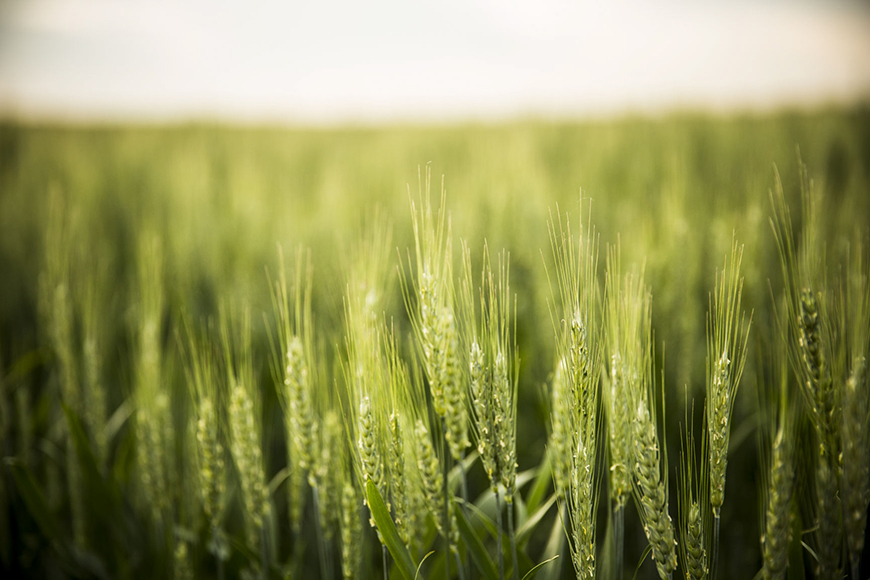In-Season Strategies to Help Maximize Wheat Performance

You’ve selected your variety and it’s in the ground. Now, what steps can you take to maximize the performance of your wheat? Unlock the next level of profit potential with these in-season management considerations.
Our Answer Plot testing and yield results can determine response-to-fungicide (RTF) scores for various wheat varieties, accounting for different growing conditions and geographies. RTF scores indicate the impact a premium fungicide application will have on a crop’s performance. Varieties with a higher RTF show significant differences when a premium fungicide is applied at herbicide timing versus a generic product. At the same time, the same application may not make as much of a difference for a variety with a low RTF. Understanding where your variety sits on the spectrum will help uncover opportunities for enhancement.
Since many growers currently use generic fungicides, we looked at the differences in performance versus premium fungicide. Premium fungicides go beyond basic disease control to help keep plants photosynthesizing under stress and increase growth efficiency. The results indicated that high-RTF wheat varieties significantly benefit when a premium fungicide is applied compared to a generic. In fact, all high-responding varieties tested showed an average response of 3.3 bushels/acre when a premium fungicide was used compared to a generic product.*
The most significant indicator of these characteristics? Response-to-nitrogen scores (RTN).
Knowing the RTN of your variety can help you make management decisions once your seed is in the ground. For example, if the variety has a low RTN, it’s likely best to stick to your average nitrogen plan, as extra investment won’t make a large enough impact to make it worth it. On the other hand, if your variety has a high RTN, you can start with your average nitrogen plan, but then come back to those fields with a nitrogen topdressing to punch up your ROI potential. When tested at our Answer Plot locations, the average yield increase when additional nitrogen was applied up-front across all varieties was 3 bushels/acre. However, the average was 4.6 bushels/acre across medium- and high-responding varieties. High-responding products alone had an average response of 6.8 bushels/acre.*
Our response-to scores also allow you to make decisions based on your specific goals. Whether your primary focus is maximizing yields or growing for high protein content, we have response scores and recommendations tailored to each. Talk with your trusted advisor about your specific goals and how you can take advantage of Answer Plot and response-to data to manage your wheat to its fullest potential.
Plus, all MAX-IN brands contain CornSorb® technology that dramatically enhances penetration for greater nutrient availability and utilization. If you find any signs of disease, take steps to eradicate it quickly to prevent significant damage. Remember that the wheat life cycle is fast, so you must act quickly, but these actions can help preserve yield potential.
*Based on 2020 WinField United Answer Plot data at five locations that evaluated all high responding wheat products, including CROPLAN®, experimental varieties and other brands.
All photos are either the property of WinField United or used with permission.
© 2022 WinField United. Important: Before use always read and follow label instructions. Crop performance is dependent on several factors many of which are beyond the control of WinField United, including without limitation, soil type, pest pressures, agronomic practices and weather conditions. Growers are encouraged to consider data from multiple locations, over multiple years and to be mindful of how such agronomic conditions could impact results. Answer Plot, CornSorb, MAX-IN, NutriSolutions and WinField are trademarks of WinField United. All other trademarks are the property of their respective owners.
Understand and Use Fungicides
Generic fungicide applications are common in wheat, but opportunities exist to make more specific selections better suited for your variety to enhance results. At our Answer Plot® sites, we’ve been testing fungicide applications on wheat for several years and have found a significant difference in fungicide response depending on the variety.Our Answer Plot testing and yield results can determine response-to-fungicide (RTF) scores for various wheat varieties, accounting for different growing conditions and geographies. RTF scores indicate the impact a premium fungicide application will have on a crop’s performance. Varieties with a higher RTF show significant differences when a premium fungicide is applied at herbicide timing versus a generic product. At the same time, the same application may not make as much of a difference for a variety with a low RTF. Understanding where your variety sits on the spectrum will help uncover opportunities for enhancement.
Since many growers currently use generic fungicides, we looked at the differences in performance versus premium fungicide. Premium fungicides go beyond basic disease control to help keep plants photosynthesizing under stress and increase growth efficiency. The results indicated that high-RTF wheat varieties significantly benefit when a premium fungicide is applied compared to a generic. In fact, all high-responding varieties tested showed an average response of 3.3 bushels/acre when a premium fungicide was used compared to a generic product.*
Get Strategic with Nutrition
The nutritional nuances of wheat largely depend on variety, so we also studied these variances at Answer Plot locations, looking for optimization opportunities. Wheat varieties are often bred for performance across variable environments, so we narrowed our focus to uncover the standouts. As a result, we identified hardy varieties that can perform on tougher soil conditions with less water, fewer nutrients and less ability to root. We also identified those that respond highly to good organic matter, nice rooting depths and good moisture and nutrient availability to deliver outstanding yields.The most significant indicator of these characteristics? Response-to-nitrogen scores (RTN).
Knowing the RTN of your variety can help you make management decisions once your seed is in the ground. For example, if the variety has a low RTN, it’s likely best to stick to your average nitrogen plan, as extra investment won’t make a large enough impact to make it worth it. On the other hand, if your variety has a high RTN, you can start with your average nitrogen plan, but then come back to those fields with a nitrogen topdressing to punch up your ROI potential. When tested at our Answer Plot locations, the average yield increase when additional nitrogen was applied up-front across all varieties was 3 bushels/acre. However, the average was 4.6 bushels/acre across medium- and high-responding varieties. High-responding products alone had an average response of 6.8 bushels/acre.*
Our response-to scores also allow you to make decisions based on your specific goals. Whether your primary focus is maximizing yields or growing for high protein content, we have response scores and recommendations tailored to each. Talk with your trusted advisor about your specific goals and how you can take advantage of Answer Plot and response-to data to manage your wheat to its fullest potential.
Prioritize Your Inputs
Monitor the conditions of your fields closely and invest your inputs where they can really make an impact. Good-looking fields with the most biomass have the greatest yield and ROI potential. For these fields, consider next-level management details, such as:- Topdressing or sidedressing your fields to maximize plant nutrition, especially on high-RTN varieties.
- Tissue testing to understand how well your plants are taking up nutrients and identify micronutrient deficiencies. The NutriSolutions® App is a convenient tool that can help you quickly identify hidden nutrient needs before yields may be compromised.
- Pay attention to response-to scores for fungicides and nitrogen to make applications tailored to your specific wheat variety and goals.
Plus, all MAX-IN brands contain CornSorb® technology that dramatically enhances penetration for greater nutrient availability and utilization. If you find any signs of disease, take steps to eradicate it quickly to prevent significant damage. Remember that the wheat life cycle is fast, so you must act quickly, but these actions can help preserve yield potential.
Plan Ahead for 2023
While variety selection and planting have passed for this spring wheat season, it’s never too early to strategize for next year’s acres. Keep these critical factors in mind as you plan.- Variety Selection: Selecting a variety that matches your ground’s characteristics is a critical step toward success. Consider factors like soil conditions, disease prevalence and response-to scores. Then, look at performance data and talk with your trusted advisor to make the proper selection for every field.
- Seeding: For wheat, precision seeding hasn’t always been emphasized. After all, the more seeds in the ground, the more yield potential, right? Turns out, that’s not always the case. Answer Plot data suggests that overpopulating seeds actually causes some yield and protein reductions because you end up with too much plant material and not enough grain. Overpopulation can also lead to lodging issues and increased disease prevalence. In many cases, reducing population helps improve overall wheat performance. To determine the best seeding rate for your variety, look at its Response-to-Population (RTP) score.
*Based on 2020 WinField United Answer Plot data at five locations that evaluated all high responding wheat products, including CROPLAN®, experimental varieties and other brands.
All photos are either the property of WinField United or used with permission.
© 2022 WinField United. Important: Before use always read and follow label instructions. Crop performance is dependent on several factors many of which are beyond the control of WinField United, including without limitation, soil type, pest pressures, agronomic practices and weather conditions. Growers are encouraged to consider data from multiple locations, over multiple years and to be mindful of how such agronomic conditions could impact results. Answer Plot, CornSorb, MAX-IN, NutriSolutions and WinField are trademarks of WinField United. All other trademarks are the property of their respective owners.





